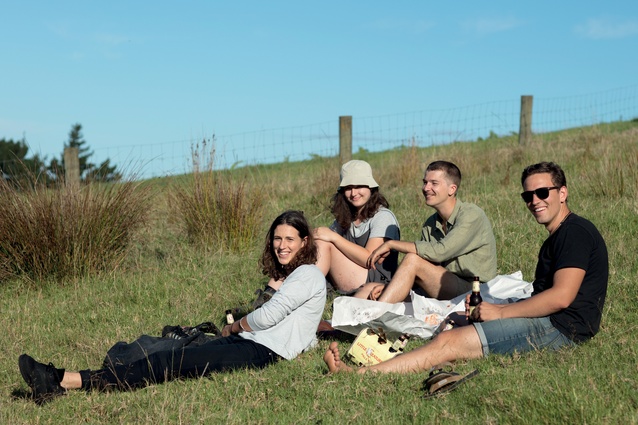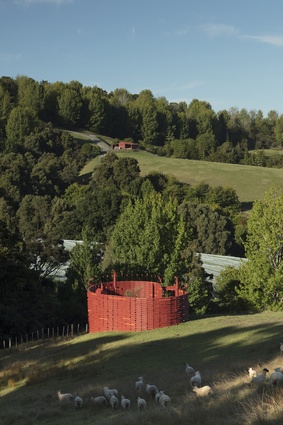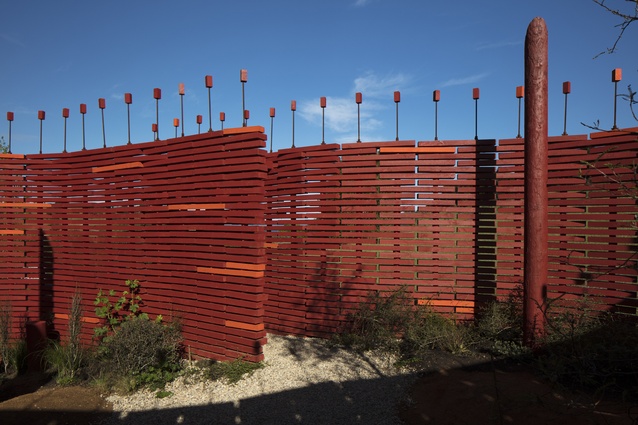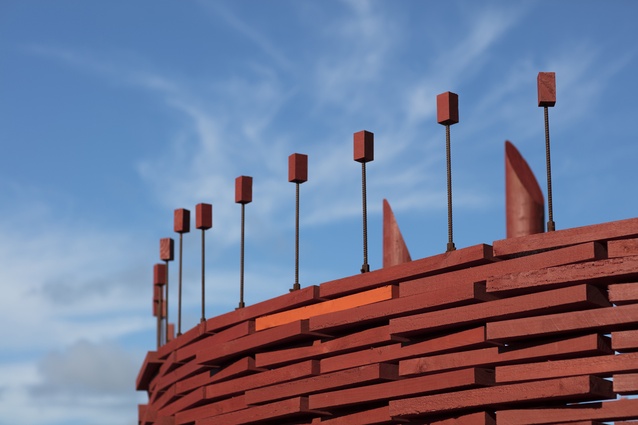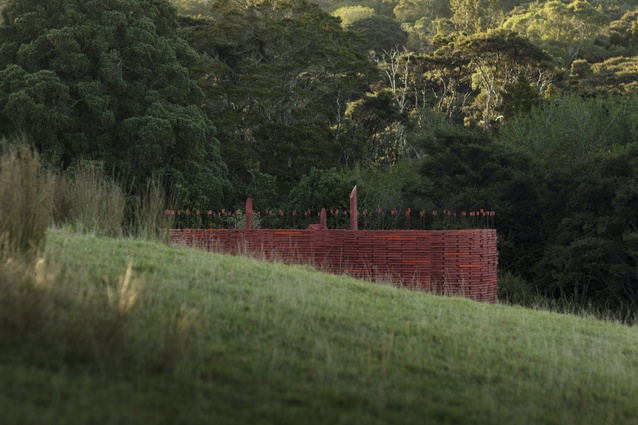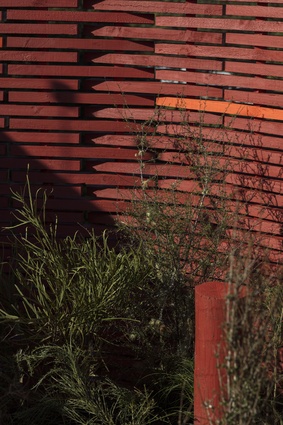Team work: Te Takitaki
This year's Brick Bay Folly winner was Te Takitaki. Based on the structure of a Māori palisade, the orange-stained timber architectural installation was designed by graduates Tom Dobinson and George Grieve, from Patterson Associates, and Sophie Edwards and Jayne Kersten, from Jasmax, in collaboration with landscape architect Winston Dewhirst from O2 Landscapes.
Half a year on from the competition, Amelia Melbourne-Hayward sat down with the team behind Te Takitaki to get some insight into the ideas, design and build process behind the striking installation that is currently sited at Brick Bay Vineyard, Warkworth.
AMH: What brought you all together to create Te Takitaki?
Jayne Kersten: These guys are a group of my closest friends. We went through 5 years at Victoria University in Wellington together and got to know each other pretty well over that time. Understanding each other’s quirks and peeves was very important in times of high stress. At the end of the day we are all still friends and hang out in the same way we did before the days of the folly, so I am calling that a win.
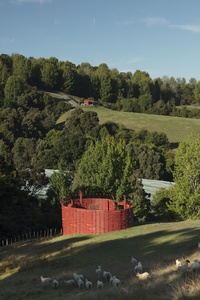
AMH: What is the inspiration(s) for the design? Why a Māori palisade?
Sophie Edwards: The design inspiration of a palisade came from the siting of the project on the top of a hillside overlooking the expansive property and out to sea. We wanted to give a sense of protection to a spot that is quite exposed otherwise, while also giving a nod to the history of the land and how that ground might have been utilised in years gone by.
It’s an interesting proposition to try and engage with traditional Māori built typology in a contemporary context – without the overtness of a wharenui form or using whakairo, and one that I don’t think we get full freedom to explore very often.
AMH: What other ideas did you have that didn’t make the final cut?
George Grieve: During the competition we had lots of design sessions before we got to the final concept, some of the ideas got carried through, and others were thrown out. In the first meeting we wrote down some things the folly should and shouldn’t be, based on the experience of previous follys, which actually included that it shouldn’t be red, so we had to reassess that.
We also had decided it needed to have a clear construction methodology, and be modular or able to be pre-fabricated off site, this provided a good filter for the early stage ideas, as we could cull the ones we thought weren’t easily buildable – a giant paper-mache egg and a levitating mass among them.
AMH: Did you gain any ideas or inspiration from the previous Folly winners?
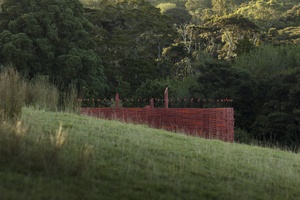
Tom Dobinson: We think the Belly of the Beast, the first Brick Bay Folly winner, was great. We went to have a look at the site and the existing folly before we designed our project, and critiqued Declan and Matt’s work with regards to how it responded to the landscape and operated as a folly. There were lots of things we admired about it, but we wanted to make sure our work stood on its own merits.
AMH: Can you tell me a bit about the technical aspects of Te Takitaki?
Jayne: When designing the folly we wanted to make sure that it was made up of a regular component, allowing for a straightforward prefabrication and assembly process. The preparation of the timber blocks was completed over a two week period in a workshop we hired in Grey Lynn. Each length was cut to size, drilled, stained and stacked ready for delivery to site.
Once the scaffold was set up on site, the main folly structure came together over a weekend. The rebar was set into the concrete footing and the blocks were threaded. We have a number of friends and family to thank for the efficiency of this process, in particular Nick Edwards. Outside of this, a lot of time was invested in the finishing touches and the interior landscape, which could not have been done without the amazing efforts of Winston Dewhirst.
AMH: What skills or knowledge did you gain from the construction process?
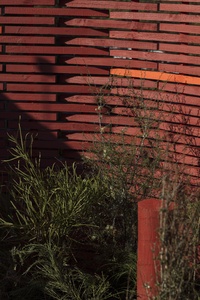
Sophie: I would say that the skills that we learnt were more project management oriented rather than practical – though there were some practical challenges that we got a lot of advice on. Even basic things like lead times on concrete before Christmas presented unexpected and stressful learning opportunities. We also found out how great it is to have a trade account at Placemakers; and the guys at Placemakers were endlessly patient with us.
AMH: Any unforeseen challenges that arose during the design and building of Te Takitaki? How did you deal with these?
George: Most of the fabrication – cutting, drilling and painting the timber – happened off site, but the space we had planned to do this in fell through without much notice, so we had to scramble to find a workshop. We ended up hiring a warehouse space in Grey Lynn which was sitting empty waiting demolition, and buying or borrowing the equipment we needed. In the end it was great, and being so close to the city meant we could go after work and had plenty of help from friends and workmates dropping by, and didn’t need to worry about making a mess!
Most of the process could have been pretty challenging, as we didn’t know for sure that our system would work, so it was a bit of a stab in the dark. We were really lucky that with the help, knowledge and tips people offered up, things ended up going pretty smoothly in the end.
AMH: Why do you think competitions like the Brick Bay Folly are worth entering?
Tom: Competitions are worth entering because they give designers a platform to promote themselves and their work. None of us are particularly great at self-promotion, so it was an interesting challenge for us to follow through with the construction of a design that we didn’t really think we would end up building. In particular, the Brick Bay Folly competition is good because it is relatively unrestricted – though this presented a challenge in terms of group work.
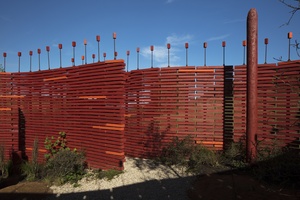
AMH: What were some of the main lessons learnt from being involved in the overall competition process of design, build and installation on site?
Jayne: While it is important to set individual tasks, it takes a team to get anything done.
Sophie: Everyone isn’t going to be happy with every decision. Sometimes you have to pick your battles and choose what not to say.
George: Learning the process of actually realizing a design was the most valuable lesson. Coordinating a team and getting in the right people to do the jobs we couldn’t was important, as we could have wasted a lot of time trying to save a small amount of money, and would have ended up with something we might not be happy with.
Having the ability to review and adapt the design on the fly was also important, and goes to show that you need to be flexible during the whole process.
Tom: You have to be careful what you draw: it might end up being built.
Te Takitaki will be exhibited at Brick Bay Vineyard for two years.

